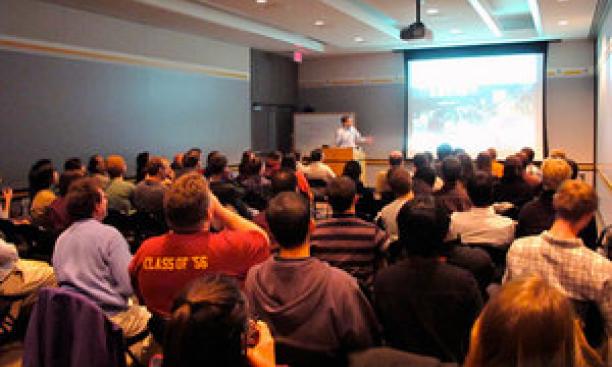

Professor Daniel Sigman led the first screening in the "Hollywood Science Gone Bad" series. (Photo: Courtesy Christine Chen '13)
As New York City was assaulted by an abnormally high tidal wave and the world rapidly began to freeze into a new ice age, laughter erupted in the Frist Campus Center basement.
The laughter came from an audience of students, faculty, and community members viewing the 2004 blockbuster The Day After Tomorrow, a film often criticized by scientists for its unrealistic portrayal of geologic events.
In the film, a rapid climate shift turns today’s conditions into a new ice age in a matter of days. To most viewers, the plot is both frightening and thrilling. To a group of geoscientists, it’s ridiculous, at best.
The screening was the first installment of “Hollywood Science Gone Bad,” a movie series organized by the newly formed Princeton Undergraduate Geosciences Society (PUGS). According to Christine Chen ’13, the group’s president, the series is “dedicated to debunking all the awful science seen in Hollywood blockbuster movies.”
The inaugural event, held March 29, attracted more than 70 viewers who watched The Day After Tomorrow and listened to short lectures and critiques from geosciences professor Daniel Sigman.
Sigman, whose research focuses on nutrient cycling and ocean biochemistry, led the group through a crash course in ocean-atmosphere interactions before the movie began. He explained that even the extraordinarily inaccurate scientific details of the film were inspired by “actual kernels of evidence,” or actual past events studied by geoscientists as well as global processes known to happen on much longer timescales.
“Up to a certain level,” Sigman said, “it’s entertaining to watch the portrayal of natural processes … and to recognize the things I know about the system and see mistakes. And then, at a certain point, you just go, ‘Oh my God.’”
As the credits rolled, Sigman tackled a few key problems with the film, describing the movie’s weather maps as the product of “hurricanes and Photoshop.”
He outlined conceptual problems with the processes that created the movie’s mega-storm, and noted a more than 30-meter difference between a plausible tidal wave and the one that struck the Statute of Liberty in the film.
Stressing the difference between weather and climate, Sigman emphasized that the dramatic climate-driven storms depicted in the film “cannot in themselves change climate,” as many other complex variables control such massive changes.
One of the most crucial problems with the film, Sigman explained, was the way it shortened realistic timescales for warming and cooling events. Where North Atlantic waters began dropping rapidly in temperature over a matter of days, the actual temperature drops would have been more gradual and spread over decades.
Sigman noted that, despite the film’s obvious inaccuracies, its take-home message was a worthwhile one. “We seem to respond poorly to non-urgent events,” he explained, stressing that humans tend to “cope poorly with even modest [environmental] change.”
The Hollywood science series could be a step in the right direction, according to Chen. “We think it’s important to educate the masses,” she said. “With all the natural disasters that are happening, every person should know at least something about earth science.”
For Gabe Eggers ’13, the film’s message and the event’s purpose aligned with a concept a former professor drilled into his students.
“You would expect any educated human being to have some idea of how the body works,” Eggers explained. “What makes it sick? What can make it better? How does it run? … Why would the Earth be any different? It affects you just as much, and you should have an idea of how it works.”

Emily Trost ’13 is a geosciences major from Huntingdon Valley, Pa.
